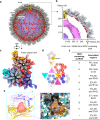Cryo-electron microscopy structures of capsids and in situ portals of DNA-devoid capsids of human cytomegalovirus
- PMID: 37041152
- PMCID: PMC10090080
- DOI: 10.1038/s41467-023-37779-0
Cryo-electron microscopy structures of capsids and in situ portals of DNA-devoid capsids of human cytomegalovirus
Abstract
The portal-scaffold complex is believed to nucleate the assembly of herpesvirus procapsids. During capsid maturation, two events occur: scaffold expulsion and DNA incorporation. The portal-scaffold interaction and the conformational changes that occur to the portal during the different stages of capsid formation have yet to be elucidated structurally. Here we present high-resolution structures of the A- and B-capsids and in-situ portals of human cytomegalovirus. We show that scaffolds bind to the hydrophobic cavities formed by the dimerization and Johnson-fold domains of the major capsid proteins. We further show that 12 loop-helix-loop fragments-presumably from the scaffold domain-insert into the hydrophobic pocket of the portal crown domain. The portal also undergoes significant changes both positionally and conformationally as it accompanies DNA packaging. These findings unravel the mechanism by which the portal interacts with the scaffold to nucleate capsid assembly and further our understanding of scaffold expulsion and DNA incorporation.
© 2023. The Author(s).
Conflict of interest statement
The authors declare no competing interests.
Figures






Similar articles
-
Cryo-Electron Tomography of the Herpesvirus Procapsid Reveals Interactions of the Portal with the Scaffold and a Shift on Maturation.mBio. 2021 Mar 16;12(2):e03575-20. doi: 10.1128/mBio.03575-20. mBio. 2021. PMID: 33727359 Free PMC article.
-
Role of the Herpes Simplex Virus CVSC Proteins at the Capsid Portal Vertex.J Virol. 2020 Nov 23;94(24):e01534-20. doi: 10.1128/JVI.01534-20. Print 2020 Nov 23. J Virol. 2020. PMID: 32967953 Free PMC article.
-
Capsids and Portals Influence Each Other's Conformation During Assembly and Maturation.J Mol Biol. 2020 Mar 27;432(7):2015-2029. doi: 10.1016/j.jmb.2020.01.022. Epub 2020 Feb 6. J Mol Biol. 2020. PMID: 32035900 Free PMC article.
-
Herpesvirus capsid assembly: insights from structural analysis.Curr Opin Virol. 2011 Aug;1(2):142-9. doi: 10.1016/j.coviro.2011.06.003. Curr Opin Virol. 2011. PMID: 21927635 Free PMC article. Review.
-
The Ins and Outs of Herpesviral Capsids: Divergent Structures and Assembly Mechanisms across the Three Subfamilies.Viruses. 2021 Sep 23;13(10):1913. doi: 10.3390/v13101913. Viruses. 2021. PMID: 34696343 Free PMC article. Review.
Cited by
-
Structure of the scaffolding protein and portal within the bacteriophage P22 procapsid provides insights into the self-assembly process.PLoS Biol. 2025 Apr 17;23(4):e3003104. doi: 10.1371/journal.pbio.3003104. eCollection 2025 Apr. PLoS Biol. 2025. PMID: 40245015 Free PMC article.
-
Structure of a new capsid form and comparison with A-, B- and C-capsids clarify herpesvirus assembly and DNA translocation.bioRxiv [Preprint]. 2025 May 8:2025.03.19.644230. doi: 10.1101/2025.03.19.644230. bioRxiv. 2025. Update in: J Virol. 2025 Jul 22;99(7):e0050425. doi: 10.1128/jvi.00504-25. PMID: 40166288 Free PMC article. Updated. Preprint.
-
Structure-guided mutagenesis targeting interactions between pp150 tegument protein and small capsid protein identify five lethal and two live-attenuated HCMV mutants.Virology. 2024 Aug;596:110115. doi: 10.1016/j.virol.2024.110115. Epub 2024 May 17. Virology. 2024. PMID: 38805802 Free PMC article.
-
Structures of Epstein-Barr virus and Kaposi's sarcoma-associated herpesvirus virions reveal species-specific tegument and envelope features.J Virol. 2024 Nov 19;98(11):e0119424. doi: 10.1128/jvi.01194-24. Epub 2024 Oct 29. J Virol. 2024. PMID: 39470208 Free PMC article.
-
Interaction of human cytomegalovirus pUL52 with major components of the viral DNA encapsidation network underlines its essential role in genome cleavage-packaging.J Virol. 2025 Apr 15;99(4):e0220124. doi: 10.1128/jvi.02201-24. Epub 2025 Mar 10. J Virol. 2025. PMID: 40062846 Free PMC article.
References
Publication types
MeSH terms
Substances
LinkOut - more resources
Full Text Sources

